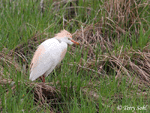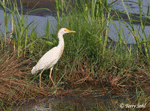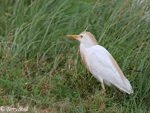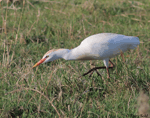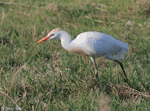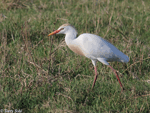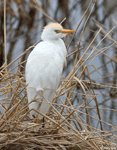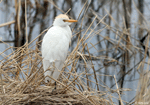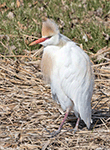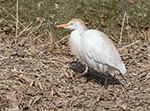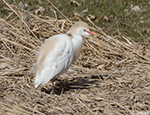| Length: 20 inches | Wingspan: 36 inches | Seasonality: Summer |
| ID Keys: Stocky build, smaller than other white egrets, yellow bill is shorter than other egrets. | ||
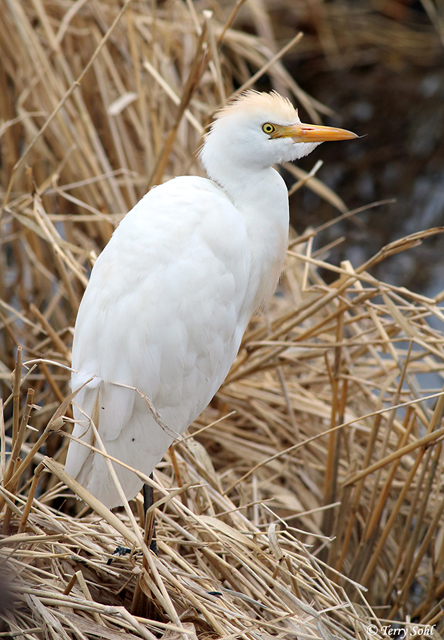 Cattle Egrets are originally native to Africa and the Mediterranean
coasts of western Europe. They began to colonize parts of South America in
the 1970's, and were first seen in the United States when breeding populations
were established in Florida in the early 1940's. Cattle Egrets have since
expanding their range to cover much of the southern U.S., and scattered
locations throughout much of the northern U.S. Cattle Egrets are unlike
other herons and egrets in that they generally feed in upland areas. They
often associating with cattle or other livestock, following the animals (or
tractors or other farm equipment) and feeding on any insects that are
disturbed. Cattle Egrets are often found in mixed breeding colonies with
other egrets and herons.
Cattle Egrets are originally native to Africa and the Mediterranean
coasts of western Europe. They began to colonize parts of South America in
the 1970's, and were first seen in the United States when breeding populations
were established in Florida in the early 1940's. Cattle Egrets have since
expanding their range to cover much of the southern U.S., and scattered
locations throughout much of the northern U.S. Cattle Egrets are unlike
other herons and egrets in that they generally feed in upland areas. They
often associating with cattle or other livestock, following the animals (or
tractors or other farm equipment) and feeding on any insects that are
disturbed. Cattle Egrets are often found in mixed breeding colonies with
other egrets and herons.
Habitat:
Can be found in nearly any kind of open country. Breeds in trees or large shrubs, sometimes associating with other egrets and herons.
Diet:
Primarily insects. Also frogs, crustaceans, earthworms, snakes, eggs and young birds, and fish.
Behavior:
Forages in a variety of habitats, but is found in dry, upland habitats much more often than most herons and egrets. Cattle egrets are often found in upland pastures and fields in search of insects.
Nesting:
June and July. The next is built on the top branches of a tree or a shrub near water, and is constructed of sticks, with larger sticks supporting the structure and smaller sticks and twigs at the top. Grasses and other vegetative material are sometimes used to line the nest. Both the male and female constructs the nest. Between two and seven eggs are laid, with incubation lasting from 3 to 4 weeks. The young fledge from the nest after about 3 weeks.
Song:
Cattle Egrets do have a variety of croaking and grunting calls. Vocalization typically occurs on the breeding grounds, as they are usually silent elsewhere.
1Click here to hear some grunting calls of a Cattle Egret
2Click here to hear a variety of alarm calls from a small group of Cattle Egret
Migration:
Summers in scattered locations throughout the United States. Winters near Gulf Coast, the southwestern U.S., and points south.
South Dakota "Hotspot"
Cattle Egrets can often be found around other egrets (Snowy Egret, Great Egret), including sometimes forming mixed breeding colonies. The region around Lake Thompson has always been a hotspot for me (although they're never common). The west side of the lake has everything the birds need, including a large water body with scattered waterside trees for nesting, and some very large cattle operations in the area that attract foraging birds.
Interactive eBird Map:
Click for access to an interactive eBird map of Cattle Egret sightings
Similar Species:
Possibly confused with 2 or 3 other "white" egret and heron species.See Identification Tips for more information on differentiating between these species.
- Snowy Egret - Structurally, Snowy Egrets are more slender with a much longer neck than a Cattle Egret. Snowy Egrets have a black bill, compared to a yellow bill for a Cattle Egret. Snowy Egrets have the characteristic yellow feet on black legs, while Cattle Egrets have yellowish to reddish legs, dependent upon season.
- Great Egret - Great Egrets are substantially larger than Cattle Egrets, with a more slender build and a much longer neck. Great Egrets appear to have a proportionally smaller head (compared to the body) than a Cattle Egret.
- Little Blue Heron - Immature Little Blue Herons are characterized by completely white plumage and may be confused with a Cattle Egret. However, like Snowy Egrets and Great Egrets, they are structurally more slender with a longer neck than a Cattle Egret. Immature Little Blue Heron also have a two toned bill (grayish and blackish), compared to the yellow bill of a Cattle Egret.
Conservation Status:
Populations still increasing and expanding in range. They are common in many parts of their range (including globally), and they are found over an extremely wide geographic area. The IUCN considers the Cattle Egret to be a species of "Least Concern".
Further Information:
2) Audubon Field Guide - Cattle Egret
Photo Information:
May 13th, 2018 -- Weisensee Slough, Minnehaha County, South Dakota -- Terry Sohl
Additional Photos:
Click on the image chips or text links below for additional, higher-resolution Cattle Egret photos.
Audio File Credits:
1Manuel Schweizer. Recorded near Valencia, Spain on April 8th, 2018. Original recording and information from xeno-canto.
2Stanislas Wroza. Recorded near Marseille, France on May 26th, 2017. Original recording and information from xeno-canto.
| Click on the map below for a higher-resolution view |
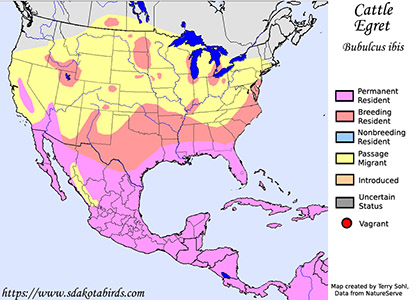 |
| South Dakota Status: Common summer breeding resident in the northeastern part of the state, uncommon elsewhere in the east, rarer in the west. Range has expanded in recent decades and newer breeding areas may not be represented on this map. |
Additional Cattle Egret Photos
Click for a higher-resolution version of these photos
